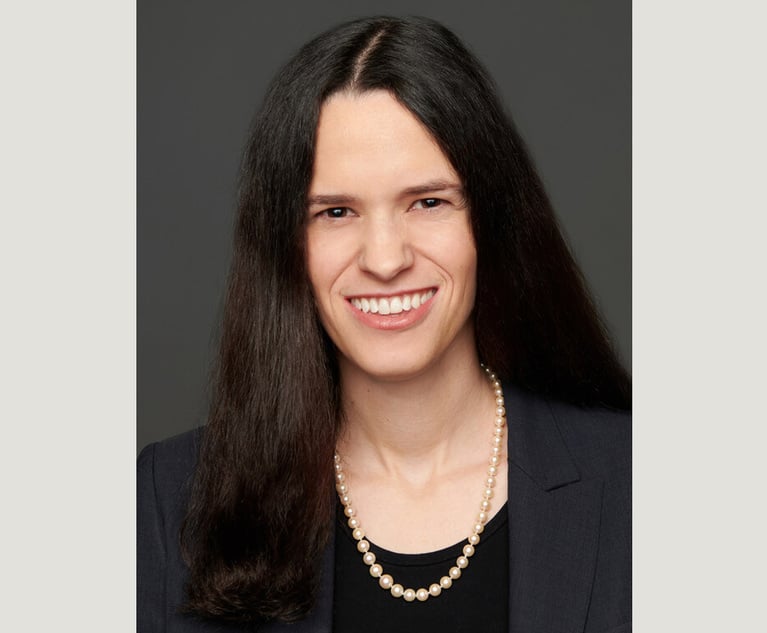In-house lawyers can become more valuable by being proactive
Legal departments can use simple tools to shift the paradigm
May 29, 2012 at 08:00 PM
3 minute read
When a legal department operates solely in a reactive mode, the business team can easily minimize its added value. However, when a legal department operates proactively to support the growth of the company with its business partners, its usefulness is readily apparent.
In the current environment of uncertainty and change, in-house counsel struggle with the legal department's role as that of a “firefighter” functioning in crisis mode only. The legal department can use certain simple tools to shift the paradigm from the reactive to the proactive mode.
One effective technique is derived from social networking principles. Over an appropriate period of time, all attorneys and paralegals should keep track of each exchange they had with business team members. The legal department should first focus on a particular department that might be the most sensitive in terms of risk and exposure.
Each member of the legal staff can use a simple grid chart. On the vertical axis of the grid should be the names of each business team member, and along the horizontal axis should be the type of contact, e.g., face-to-face meeting, telephone call or email. The staff member should keep track of each contact with a business team member by checking the grid in the appropriate box.
Once the time period is over, tabulate the information on the charts for each staff member and for the entire legal department. Each attorney or paralegal should carefully review her own information. She will readily determine the business team members with whom she interacts and the frequency of contact—probably something that she already intuitively knows. More importantly, she will see the gaps where minimal or no contact has been made. The gap may be a particular individual or may be a sub-unit within a department. The attorney or the general counsel, depending on the level of risk associated with the individual's responsibilities, should engage in a friendly inquiry. This almost always results in better contact between the individual or sub-unit and the legal department.
In reviewing the overall results, the general counsel can make some meaningful observations. Is a disproportionate amount of legal resources being devoted to a portion of the business that does not generate the profit to warrant the level of activity? Is the legal department focusing on those individuals aligned with the strategic aspects of the business? Is the legal staff heavily relying on email exchanges with its clients? Is there a sufficient degree of “face time”?
In a business that requires continuous legal support for compliance matters, establish a system that keeps track of each matter handled by the legal department and then accumulates the data on a monthly basis. By compiling the information on a monthly basis and converting the data into graphs and charts, the legal team can see whether there has been an increase in demand over time and allocate its resources accordingly.
Off-the-shelf expense-tracking software can follow the business sources generating outside legal expenses. The department must categorize fees in each itemized outside counsel invoice by department, division or project. In reviewing monthly results, focus on practice areas with considerable outside counsel fees. If you observe that the company regularly needs the resources of a firm specializing in an area of law where there is already in-house expertise, use that information to shift the responsibilities to the legal staff in order to handle the workload internally and reduce the costs associated with outside firms.
By employing these tools effectively, the corporate legal team will be better able to allocate the resources necessary to reduce the company's risks and engage those business members with whom it has not had sufficient interaction. The in-house counsel will be much better poised to become a more proactive player in the business.
Thomas Lalla is SVP and GC of Pernod Ricard USA.
This content has been archived. It is available through our partners, LexisNexis® and Bloomberg Law.
To view this content, please continue to their sites.
Not a Lexis Subscriber?
Subscribe Now
Not a Bloomberg Law Subscriber?
Subscribe Now
NOT FOR REPRINT
© 2025 ALM Global, LLC, All Rights Reserved. Request academic re-use from www.copyright.com. All other uses, submit a request to [email protected]. For more information visit Asset & Logo Licensing.
You Might Like
View All
Advertising Tech Likely to Draw More Scrutiny in 2025 Over Consumers' Data, Lawyers Say
5 minute read

'Be Comfortable Being Uncomfortable': Pearls of Wisdom From 2024 GC Q&As

In-House Moves of the Month: Boeing Loses Another Lawyer, HubSpot Legal Chief Out After 2 Years
5 minute readTrending Stories
- 1Data Breach Lawsuit Against Byte Federal Among 1,500 Targeting Companies in 2024
- 2Counterfeiters Ride Surge in Tabletop Games’ Popularity, Challenging IP Owners to Keep Up
- 3Health Care Data Breach Class Actions Saw December Surge in NY Courts
- 4Florida Supreme Court Disbars 3, Suspends 11, Reprimands 1 in Final Disciplinary Order of 2024
- 5Chief Justice Roberts Ends Year With Defense Against 'Illegitimate' Attacks on Judiciary
Who Got The Work
Michael G. Bongiorno, Andrew Scott Dulberg and Elizabeth E. Driscoll from Wilmer Cutler Pickering Hale and Dorr have stepped in to represent Symbotic Inc., an A.I.-enabled technology platform that focuses on increasing supply chain efficiency, and other defendants in a pending shareholder derivative lawsuit. The case, filed Oct. 2 in Massachusetts District Court by the Brown Law Firm on behalf of Stephen Austen, accuses certain officers and directors of misleading investors in regard to Symbotic's potential for margin growth by failing to disclose that the company was not equipped to timely deploy its systems or manage expenses through project delays. The case, assigned to U.S. District Judge Nathaniel M. Gorton, is 1:24-cv-12522, Austen v. Cohen et al.
Who Got The Work
Edmund Polubinski and Marie Killmond of Davis Polk & Wardwell have entered appearances for data platform software development company MongoDB and other defendants in a pending shareholder derivative lawsuit. The action, filed Oct. 7 in New York Southern District Court by the Brown Law Firm, accuses the company's directors and/or officers of falsely expressing confidence in the company’s restructuring of its sales incentive plan and downplaying the severity of decreases in its upfront commitments. The case is 1:24-cv-07594, Roy v. Ittycheria et al.
Who Got The Work
Amy O. Bruchs and Kurt F. Ellison of Michael Best & Friedrich have entered appearances for Epic Systems Corp. in a pending employment discrimination lawsuit. The suit was filed Sept. 7 in Wisconsin Western District Court by Levine Eisberner LLC and Siri & Glimstad on behalf of a project manager who claims that he was wrongfully terminated after applying for a religious exemption to the defendant's COVID-19 vaccine mandate. The case, assigned to U.S. Magistrate Judge Anita Marie Boor, is 3:24-cv-00630, Secker, Nathan v. Epic Systems Corporation.
Who Got The Work
David X. Sullivan, Thomas J. Finn and Gregory A. Hall from McCarter & English have entered appearances for Sunrun Installation Services in a pending civil rights lawsuit. The complaint was filed Sept. 4 in Connecticut District Court by attorney Robert M. Berke on behalf of former employee George Edward Steins, who was arrested and charged with employing an unregistered home improvement salesperson. The complaint alleges that had Sunrun informed the Connecticut Department of Consumer Protection that the plaintiff's employment had ended in 2017 and that he no longer held Sunrun's home improvement contractor license, he would not have been hit with charges, which were dismissed in May 2024. The case, assigned to U.S. District Judge Jeffrey A. Meyer, is 3:24-cv-01423, Steins v. Sunrun, Inc. et al.
Who Got The Work
Greenberg Traurig shareholder Joshua L. Raskin has entered an appearance for boohoo.com UK Ltd. in a pending patent infringement lawsuit. The suit, filed Sept. 3 in Texas Eastern District Court by Rozier Hardt McDonough on behalf of Alto Dynamics, asserts five patents related to an online shopping platform. The case, assigned to U.S. District Judge Rodney Gilstrap, is 2:24-cv-00719, Alto Dynamics, LLC v. boohoo.com UK Limited.
Featured Firms
Law Offices of Gary Martin Hays & Associates, P.C.
(470) 294-1674
Law Offices of Mark E. Salomone
(857) 444-6468
Smith & Hassler
(713) 739-1250






